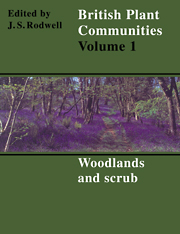Book contents
- Frontmatter
- Contents
- List of Figures
- Foreword
- Preface and Acknowledgements
- Preamble
- General Introduction
- Woodlands and Scrub
- Introduction to Woodlands and Scrub
- Key To Woodlands and Scrub
- Community Descriptions
- W1 Salix Cinerea-Galium Palustre woodland
- W2 Salix Cinerea-Betula Pubescens-Phragmites Australis Woodland
- W3 Salix Pentandra-Carex Rostrata Woodland
- W4 Betula Pubescens-Molinia Caerulea Woodland
- W5 Alnus Glutinosa-Carex Paniculata Woodland
- W6 Alnus Glutinosa-Urtica Jzozca Woodland
- W7 Ainus Glutinosa-Fraxinus Excelsior-Lysimachia Nemorum Woodland
- W8 Fraxinus Excelsior-Acer Campestre-Mercurialis Perennis Woodland
- W9 Fraxinus Excelsior-Sorbus Aucuparia-Mercurialis Perennis Woodland
- W10 Quereus Robur-Pteridium Aquilinum-Rubus Fruticosus Woodland
- W11 Quereus Petraea-Betula Pubescens-Oxalis Acetosella Woodland
- W12 Fagus Sylvatica-Mercurialis Perennis Woodland
- W13 Taxus Baccata Woodland
- W14 Fagus Sylvatica-Rubus Fruticosus Woodland
- W15 Fagus Sylvatica-Deschampsia Flexuosa Woodland
- W16 Quereus spp.-Betula spp.-Deschampsia Flexuosa Woodland
- W17 Quereus Petraea-Betula Pubescens-Dicranum Majus Woodland
- W18 Pinus Sylvestris-Hylocomium Splendens Woodland
- W19 Juniperus Communis Ssp. Communis-Oxalis Acetosella Woodland
- W20 Salix Lapponum-Luzula Sylvatica Scrub
- W21 Crataegus monogyna-Hedera helix scrub
- W22 Prunus Spinosa-Rubus Fruticosus Scrub
- W23 Ulex Europaeus-Rubus Fruticosus Scrub
- W24 Rubus Fruticosus-Holcus Lanatus Underscrub
- W25 Pteridium Aquilinum-Rubus Fruticosus Underscrub
- Index of Synonyms to Woodlands and Scrub
- Index of Species in Woodlands and Scrub
- Bibliography
W12 - Fagus Sylvatica-Mercurialis Perennis Woodland
Published online by Cambridge University Press: 04 July 2020
- Frontmatter
- Contents
- List of Figures
- Foreword
- Preface and Acknowledgements
- Preamble
- General Introduction
- Woodlands and Scrub
- Introduction to Woodlands and Scrub
- Key To Woodlands and Scrub
- Community Descriptions
- W1 Salix Cinerea-Galium Palustre woodland
- W2 Salix Cinerea-Betula Pubescens-Phragmites Australis Woodland
- W3 Salix Pentandra-Carex Rostrata Woodland
- W4 Betula Pubescens-Molinia Caerulea Woodland
- W5 Alnus Glutinosa-Carex Paniculata Woodland
- W6 Alnus Glutinosa-Urtica Jzozca Woodland
- W7 Ainus Glutinosa-Fraxinus Excelsior-Lysimachia Nemorum Woodland
- W8 Fraxinus Excelsior-Acer Campestre-Mercurialis Perennis Woodland
- W9 Fraxinus Excelsior-Sorbus Aucuparia-Mercurialis Perennis Woodland
- W10 Quereus Robur-Pteridium Aquilinum-Rubus Fruticosus Woodland
- W11 Quereus Petraea-Betula Pubescens-Oxalis Acetosella Woodland
- W12 Fagus Sylvatica-Mercurialis Perennis Woodland
- W13 Taxus Baccata Woodland
- W14 Fagus Sylvatica-Rubus Fruticosus Woodland
- W15 Fagus Sylvatica-Deschampsia Flexuosa Woodland
- W16 Quereus spp.-Betula spp.-Deschampsia Flexuosa Woodland
- W17 Quereus Petraea-Betula Pubescens-Dicranum Majus Woodland
- W18 Pinus Sylvestris-Hylocomium Splendens Woodland
- W19 Juniperus Communis Ssp. Communis-Oxalis Acetosella Woodland
- W20 Salix Lapponum-Luzula Sylvatica Scrub
- W21 Crataegus monogyna-Hedera helix scrub
- W22 Prunus Spinosa-Rubus Fruticosus Scrub
- W23 Ulex Europaeus-Rubus Fruticosus Scrub
- W24 Rubus Fruticosus-Holcus Lanatus Underscrub
- W25 Pteridium Aquilinum-Rubus Fruticosus Underscrub
- Index of Synonyms to Woodlands and Scrub
- Index of Species in Woodlands and Scrub
- Bibliography
Summary
Synonymy
Beechwood association Moss et al. 1910p.p.; Fagetum sylvaticae calcareum Tansley & Rankin 1911; Fagetum sylvaticae beech woods on Chalk Adamson 1921; Beech associes, seres 3 & 4 Watt 1924; Beech consociation, Juniper and Hawthorn seres Watt 1934a; Beech consociation, seres 3 & 4 Watt 19346; Fagetum sylvaticae calcicolum Tansley 1939; Fagetum rubosum Tansley 1939 p.p.; Beech-Ash-Yew Association McNeil 1961; Beech-Oak-Ash Association McNeill 1961 p.p.; Cotswold beechwoods Barkham & Norris 1967 p.p.; Beechwood Rackham 1980 p.p.; Beech stand types 8Cb & 8Cc Peterken 1981; Woodland plot types 1 & 8 Bunce 1982 p.p.
Constant species
Fagus sylvatica, Mercurialis perennis.
Rare species
Buxus sempervirens, Cephalanthera longifolia, C. rubra, Cynoglossum germanicum, Epipactis leptochila, Epipogium aphyllum, Hordelymus europaeus, Orchis purpurea.
Physiognomy
The Fagus sylvatica-Mercurialis perennis woodland is one of three woodland communities in Britain characterised by the great pre-eminence of Fagus sylvatica. In this community, Fagus is the only woody species that is constant throughout and is always the most abundant tree: in mature stands, it is an overwhelming dominant in a usually quite distinct topmost tier to the canopy. In general, though, and especially on the more shallow soils of the Sanicula and Taxus sub-communities, the individual trees do not attain the majestic stature so typical of the Fagus sylvatica-Rubus fruticosus woodland. There can also be considerable variation in the overall canopy height and in the distribution and physiognomy of the trees according to the age of the woodland and younger sub-spontaneous stands can continue to betray the pattern of invasion by Fagus for some time. In some of the woodlands which Watt (1924, 1934a) examined, for example, he detected varied mixtures of pioneers, families and groups of different sizes and degrees of maturity and noted a contrast between the stocky, richlybranched early invaders with their spreading crowns and individuals of subsequent generations with taller, thinner boles, often obliquely set and with lop-sided crowns crowded by the existing trees. With increasing age, however, the Fagus cover takes on a more even and regular look and younger trees become progressively confined to gaps with slow and sometimes sporadic regeneration.
- Type
- Chapter
- Information
- British Plant Communities , pp. 217 - 233Publisher: Cambridge University PressPrint publication year: 1991



